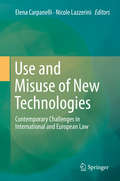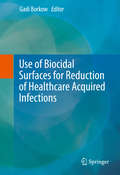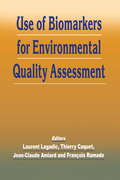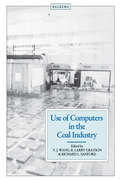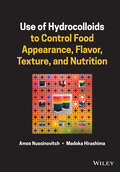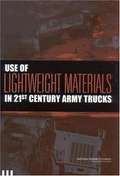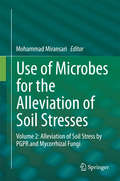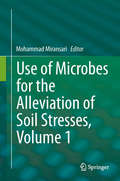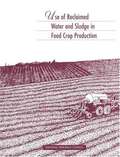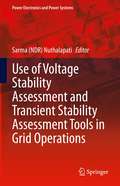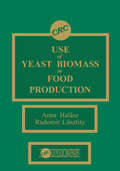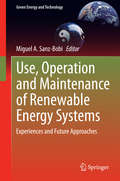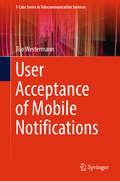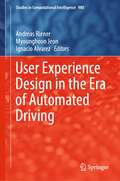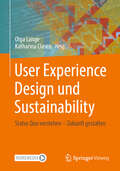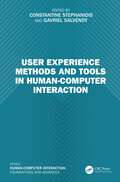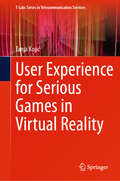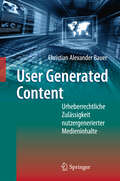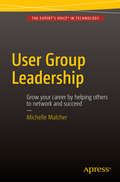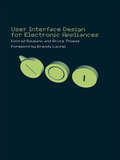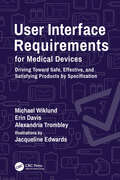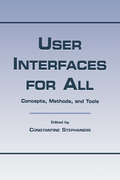- Table View
- List View
Use and Misuse of New Technologies: Contemporary Challenges in International and European Law
by Elena Carpanelli Nicole LazzeriniThe ever-increasing use of technology is challenging the current status of the law, bringing about new problems and questions. The book addresses this trend from the perspective of International law and European Union law and is divided into three main thematic sections. The first section focuses on the legal implications of the use of technology either for law enforcement purposes or in the context of military activities, and examines how this use adds a new dimension to perennial issues, such as the uneasy balance between security concerns and the protection of individual rights, and defining the exact scope of certain State obligations. In so doing, it takes into account a range of current and potential scenarios at the international, regional and domestic level, including the use of killer robots, databases, drones and technology in general to patrol borders, exchange information on criminal suspects, maintain public order, target suspected terrorists and conduct military activities. In turn, the second section examines the role of institutional and non-institutional actors in establishing substantive normative standards for the use of high-tech applications. In this respect, it focuses both on the role that European courts have played so far, and on how other actors’ initiatives can contribute to the construction of a new legal framework for technology-related activities. Lastly, the third section has a two-fold focus: the first part investigates how the increasing reliance on technology is affecting traditional rules on international responsibility, and is challenging, in particular, the attribution of wrongful conduct to States and international organizations. The second part addresses issues of jurisdiction and justiciability. Given the scope of its coverage, this timely book addresses an important lacuna in the current legal scholarship, exploring some of the most recent applications of technology and the legal issues arising as a result. Readers will gain novel insights into the challenges posed to International law and European law by the growing reliance on technology, taking into account both its uses and misuses.
Use of AI, Robotics and Modelling tools to fight Covid-19
by Mangey Ram Abhinav Sharma Arpit Jain Jianwu WangThe COVID-19 pandemic has hit the global at a colossal scale. With worldwide reported cases of 5.34 million it has led to severe impact on humanity. Being a highly contagious disease, it has given global health services their most severe challenge. Various countries are fighting to minimize the losses due to the outbreak, however a common trait is enforcing lockdown, which has become the main defence mechanism. Researchers are working around the clock to find a breakthrough in the diagnostics and treatment of the pandemic.AI technology is useful for fast drug development and treatment. In the starting phase of COVID-19 pandemic, the medical fraternity in China diagnosed the virus using computed tomography (CT) and X-ray images due to the limitation of testing kits. Deep learning neural network model have also been used for COVID-19 diagnosis. AI assisted intelligent humanoid robots can be used to reduce the human contact and spread of COVID-19. In Italy robots have been used for measuring blood pressure, oxygen saturation and temperature of patients. Robots have also found applications in disinfecting and sterilizing of public places, COVID-19 testing, food and medicine delivery as well as entertaining patients in hospitals and quarantine centers, thereby reducing the workload of doctors and nurses.Prediction of the spread of virus and providing the guidelines or prevention measures is another AI application in COVID-19. Kaggle and GitHub are the two websites where the real-time data of COVID-19 is aggregated. This includes confirmed cases, active cases, cured cases and deaths in each country. This data set can be used for predicting the active cases across different regions of the world so that appropriate amount of health infrastructure can be made available to these places.
Use of Biocidal Surfaces for Reduction of Healthcare Acquired Infections
by Gadi BorkowThe notion that contaminated environments in hospital settings significantly contribute to the risk of an individual acquiring an infection while hospitalized is continuously gaining recognition by the medical community. There is a clear correlation between the environmental bioburden present in a clinical setting and the risk of patients acquiring an infection. Thus using self-disinfecting surfaces can be a very important adjunct in the fight against nosocomial pathogens. This book reviews the increasing evidence that contaminated non-intrusive soft and hard surfaces located in the clinical surroundings are a source of nosocomial pathogens and focuses on the utility of copper containing materials in reducing bioburden and fighting hospital acquired infections. It also reviews other biocidal surface alternatives and the economics of using biocidal surfaces in a hospital environment. Finally, it discusses the pros and cons of existent disinfection modalities other than biocidal surfaces.
Use of Biomarkers for Environmental Quality Assessment
by Jean-Claude Amiard Thierry Caquet Laurent LagadicThis work is primarily designed for any person or organization in charge of assessment of the quality of natural resources and of pollution prevention.
Use of Cassava Wastewater and Scheelite Residues in Ceramic Formulations (Green Energy and Technology)
by Wilson Acchar Vamberto Monteiro da SilvaThis book presents original results on the use of cassava wastewater as a substitute for potable water in ceramic formulations. It evaluates the physical and mechanical properties as well as the microstructure of the materials produced, comparing the products obtained from the incorporating effluent with the conventional materials used in the construction industry.
Use of Computers in the Coal Industry 1986
by Y.J. Wang, R. Larry Grayson and Richard L. SanfordThis book is an outcome of the third conference on the use of computers in the coal industry in Morgantown. It presents valuable computer applications covering the most aspects of coal industry and covers following areas: mine management and economics; surface mining; coal preparation; and blasting.
Use of Hydrocolloids to Control Food Appearance, Flavor, Texture, and Nutrition
by Amos Nussinovitch Madoka HirashimaUse of Hydrocolloids to Control Food Appearance, Flavor, Texture, and Nutrition A thoroughly up-to-date and forward-looking presentation of the use of hydrocolloids in food In Use of Hydrocolloids to Control Food Appearance, Flavor, Texture, and Nutrition, a team of distinguished food researchers combines comprehensive and authoritative discussions on the conventional use of hydrocolloids to influence shape, structure and organoleptic properties of foods with exciting and emerging areas of innovation, such as texturing for 3D printing and enhancement of food nutrition. The book explores the four principal quality factors of food: appearance, flavor, texture and nutrition, and introduces students and food technologists to the myriad uses of hydrocolloids. It also presents illustrations of relevant commercial food products that rely on hydrocolloids for their appeal, as well as recipes exemplifying the unique abilities of particular hydrocolloids. Readers will also find: A thorough introduction to the use of hydrocolloids to control food size and shape, including the manipulation of select geometrical properties of foods A comprehensive exploration of the use of hydrocolloids to modulate food color and gloss, including the psychological impact of those properties Practical discussions pertaining to the modification of food taste and odor using hydrocolloids A thorough description of the ways in which hydrocolloids are used to improve crispy, crunchy and crackly foods Perfect for food scientists working in product development and food engineers, Use of Hydrocolloids to Control Food Appearance, Flavor, Texture, and Nutrition is sure to earn a place in the libraries of research chefs, as well as food chemists, food microbiologists and food technologists.
Use of Lightweight Materials in 21st Century Army Trucks
by National Resource CouncilIn order to achieve the Army's envisioned Objective Force related to deployability, transportability, and mobility, the Committee on Lightweight Materials for the 21st Century Army Trucks was asked to identify research and technology development opportunities related to the introduction of new lightweight structural materials for light, medium and heavy Army trucks.
Use of Microbes for the Alleviation of Soil Stresses
by Mohammad MiransariUse of Microbes for the Alleviation of Soil Stresses, Volume 2: Alleviation of Soil Stress by PGPR and Mycorrhizal Fungi describes the most important details and advances related to the alleviation of soil stresses by PGPR and mycorrhizal fungi. Comprised of eleven chapters, the book reviews the role of arbuscular mycorrhizal fungi in alleviation of salt stress, the role of AM fungi in alleviating drought stress in plants, the impact of biotic and abiotic stressors and the use of mycorrhizal fungi to alleviate compaction stress on plant growth. Written by experts in their respective fields, Use of Microbes for the Alleviation of Soil Stresses, Volume 2: Alleviation of Soil Stress by PGPR and Mycorrhizal Fungi is a comprehensive and valuable resource for researchers and students interested in the field of microbiology and soil stresses.
Use of Microbes for the Alleviation of Soil Stresses, Volume 1
by Mohammad MiransariUse of Microbes for the Alleviation of Soil Stresses, Volume 1 describes the most important details and advances related to the alleviation of soil stresses by soil microbes. Comprised of seven chapters, the book reviews the mechanisms by which plant growth promoting rhizobacteria (PGPR) alleviate plant growth under stress; the role of mycorrhizal fungi on the alleviation of drought stress in host plants; how PGPR may alleviate salinity stress on the growth of host plants; and the role of PGPR on the growth of the host plant under the stress of sub optimal root zone temperature. Written by experts in their respective fields, Use of Microbes for the Alleviation of Soil Stresses, Volume 1 is a comprehensive and valuable resource for researchers and students interested in the field of microbiology and soil stresses.
Use of Reclaimed Water and Sludge in Food Crop Production
by Committee on the Use of Treated Municipal Wastewater Effluents Sludge in the Production of Crops for Human ConsumptionThis book reviews the practice of reclaiming treated municipal wastewater for agricultural irrigation and using sewage sludge as a soil amendment and fertilizer in the United States. It describes and evaluates treatment technologies and practices; effects on soils, crop production, and ground water; public health concerns from pathogens and toxic chemicals; existing regulations and guidelines; and some of the economic, liability, and institutional issues. The recommendations and findings are aimed at authorities at the federal, state, and local levels, public utilities, and the food processing industry.
Use of Voltage Stability Assessment and Transient Stability Assessment Tools in Grid Operations (Power Electronics and Power Systems)
by Sarma Ndr NuthalapatiThis book brings together real-world accounts of using voltage stability assessment (VSA) and transient stability assessment (TSA) tools for grid management. Chapters are written by leading experts in the field who have used these tools to manage their grids and can provide readers with a unique and international perspective. Case studies and success stories are presented by those who have used these tools in the field, making this book a useful reference for different utilities worldwide that are looking into implementing these tools, as well as students and practicing engineers who are interested in learning the real-time applications of VSA and TSA for grid operation.
Use of Yeast Biomass in Food Production
by Radomir Lasztity Anna HalaszYeast biomass is an excellent source of proteins, nucleic acids, and vitamins. It has been produced and consumed in baked goods and other foods for thousands of years and offers significant advantages when compared to other potential new microbial protein sources. Use of Yeast Biomass in Food Production provides up-to-date information regarding the chemical composition and biochemistry of yeasts, discusses the biotechnological basis of yeast production and possibilities for influencing yeast biomass composition using new techniques in molecular biology. The book examines techniques for producing yeast protein concentrates (and isolates) while still retaining their functional properties and nutritive values, as well as the various uses for these materials and their derivatives in different branches of the food industry. Finally, the book explores possibilities for the production and industrial use of other yeast components, such as nucleic acids, nucleotides, cell wall polysaccharides, autolysates, and extracts. Food microbiologists and technologists, as well as biotechnologists, will discover that this book is an invaluable reference resource.
Use, Operation and Maintenance of Renewable Energy Systems
by Miguel A. Sanz-BobiThis book addresses the use, operation and maintenance of new renewable energy systems, taking into account their integration in the current electrical markets and in the new emergent uses of energy. The book is based on practical experiences which present different perspectives about what occurs once an energy production plant based on sources of renewable energy is in production. Questions to be addressed include: how the energy produced is integrated into the current system of energy production, what is its consideration in the electrical market, what the impact is on society, how differential the strategies of operation and maintenance are with respect to conventional systems of energy production, etc.
User Acceptance of Mobile Notifications
by Tilo WestermannThis book presents an alternative approach to studying smartphone-app user notifications. It starts with insights into user acceptance of mobile notifications in order to provide tools to support users in managing these. It extends previous research by investigating factors that influence users' perception of notifications and proposes tools addressing the shortcomings of current systems. It presents a technical framework and testbed as an approach for evaluating the usage of mobile applications and notifications, and then discusses a series of studies based on this framework that investigate factors influencing users' perceptions of mobile notifications. Lastly, a set of design guidelines for the usage of mobile notifications is derived that can be employed to support users in handling notifications on smartphones.
User Design
by Alison A. Carr-ChellmanUser Design offers a fresh perspective on how front-line learners (users) can participate in the design of learning environments. The author challenges the universal assumption that front-line users must be relegated to the role of offering input, and that the actual design activity of learning systems must still be conducted only by experts. The b
User Experience Design in the Era of Automated Driving (Studies in Computational Intelligence #980)
by Andreas Riener Myounghoon Jeon Ignacio AlvarezThis book is dedicated to user experience design for automated driving to address humane aspects of automated driving, e.g., workload, safety, trust, ethics, and acceptance. Automated driving has experienced a major development boost in recent years. However, most of the research and implementation has been technology-driven, rather than human-centered. The levels of automated driving have been poorly defined and inconsistently used. A variety of application scenarios and restrictions has been ambiguous. Also, it deals with human factors, design practices and methods, as well as applications, such as multimodal infotainment, virtual reality, augmented reality, and interactions in and outside users. This book aims at 1) providing engineers, designers, and practitioners with a broad overview of the state-of-the-art user experience research in automated driving to speed-up the implementation of automated vehicles and 2) helping researchers and students benefit from various perspectives and approaches to generate new research ideas and conduct more integrated research.
User Experience Design und Sustainability: Status Quo verstehen – Zukunft gestalten
by Olga Lange Katharina ClasenDieses Buch ist ein Handbuch für alle Gestalter*innen, die mit User Experience (UX) Design mehr zur nachhaltigen Entwicklung von Systemen, Produkten und Dienstleistungen beitragen möchten. Arbeitskreis "Design for Sustainability" der German UPA wurde im Jahr 2023 gegründet und widmet sich allen aktuellen Themen aus dem Bereich UX für Nachhaltigkeit. Als Grundlage für dieses Werk diente eine umfassende Umfrage der UX-Gestalter: innen zum Thema "Design for Sustainability". Somit wurde ein Status Quo erfasst, um die zukunftsweisenden Beiträge und Handlungsempfehlungen für die Zukunft auszuarbeiten. Viel Spaß beim Lesen und Umsetzen!
User Experience Methods and Tools in Human-Computer Interaction
by Gavriel Salvendy Constantine StephanidisThis book covers user experience methods and tools in designing user‑friendly products and servicesby encompassing widely utilized successful methods, including elicitation, analysis and establishment of requirements, collaborative idea generation with design teams and intended users, prototype testing and evaluation of the user experience through empirical and non‑empirical means.This book• Provides methods and tools tailored for each stage of the design process.• Discusses methods for the active involvement of users in the human‑centered design process.• Equips readers with an effective toolset for use throughout the design process, ensuring that what is created aligns with user needs and desires.• Covers a wide array of research and evaluation methods employed in HCI, from the initiation of the human‑centered development cycle to its culmination.This book is a fascinating read for individuals interested in Human-Computer Interaction research and applications.
User Experience for Serious Games in Virtual Reality (T-Labs Series in Telecommunication Services)
by Tanja KojićThe book presents research in understanding how to make Virtual Reality (VR) applications more enjoyable and realistic. The author studies this in relation not just to VR games for entertainment, but also for other applications such as serious games, which are used for education and training. To make VR games better, the work examines topics like the content in the game, the context in which it's played, and human factors like one’s age, and previous experience with VR. By understanding these factors, the author creates guidelines to make VR games more engaging and user-friendly. The primary purpose of this work is to evaluate and identify different influences on User Experience (UX) for VR serious games, intending to narrow the research gap between Influencing Factors (IFs), UX, and design guidelines for VR serious games. With eight user studies and five different VR serious games developed, different influences and links between those factors and UX components are investigated.
User Generated Content
by Christian Alexander BauerDas Web 2.0 hat zu einem Wandel des Nutzerverhaltens in Internet geführt: Immer mehr Nutzer gehen vom passiven Konsum über zu einem interaktiven Nutzungsverhalten. Bei einem Großteil der produzierten Beiträge greifen sie dabei auf fremde, zumeist urheberrechtlich geschützte Inhalte zurück. Vor diesem Hintergrund geht der Autor der Frage nach, inwieweit diese unautorisierte Verwendung fremder Werke und Leistungen urheberrechtlich zulässig ist und in welchem Umfang dieses Phänomen zukünftig vom Gesetzgeber privilegiert werden sollte.
User Group Leadership
by Michelle MalcherThis book is about starting and sustaining a technology user group. User groups are a wonderful way to connect with local and like-minded professionals for networking and learning. All the forums and social media on the internet can't replace face-to-face time spent discussing problems, upcoming technologies, and other pertinent topics. What every user group needs is leaders to organize meetings, find speakers, and connect the community. What every leader needs is good advice and guidance on how to begin a group and nurture new leadership to keep the group sustainable, and Michelle Malcher provides just that right sort of guidance in her book on User Group Leadership. This book is designed to help you understand what goes into starting and building a user group, giving you the tools and resources to do so. Learn what to expect before your first meeting, in the first three months, and in the first year. Malcher has experience from the local group level on up to the international level with the Independent Oracle User Group. If you're involved in technology and are ready to take on a position of leadership by which to help others network, succeed, and grow, then grab a copy of this book. You won't find a better source of guidance for starting and growing a new group on the technology of your choice. Learn what to know before you ever have your first meeting Prepare for each meeting with a list of things that should be done Grow your local members into future leaders What you'll learn Choose the right motivations for starting a group Build a governance structure and integrate with an umbrella group Locate and book interesting speakers Recruit help to share the administrative burden Grow the next generation of leadership Make a difference in people's careers by helping them grow and network and learn Who this book is for User Group Leadership is aimed at technology professionals interested in networking and learning with like-minded people in their same technology area. The book is especially aimed at the ambitious professional who is ready to step into a leadership role by creating a vibrant user community where no such community currently exists, but one is needed. Table of Contents 1. Development of a User Group 2. User Group Governance 3. Building Leaders and Volunteers 4. User Group Planning 5. User Group Members 6. Challenges 7. Career Development 8. From Techie to Leader 9. Qualities of a User Group Leader 10. Qualities of a User Group Volunteer
User Interface Design of Electronic Appliances
by Bruce Thomas Konrad BaumannThis simple and manageable guide to user interface design is written for the professional in industry working on product development and the decision process. It is directed not only to the human factors specialists, but also to technicians, designers, marketing and product managers and students.The book presents guidelines for user interface d
User Interface Requirements for Medical Devices: Driving Toward Safe, Effective, and Satisfying Products by Specification
by Erin Davis Michael Wiklund Alexandria TrombleyThis book is a practical guide for individuals responsible for creating products that are safe, effective, usable, and satisfying in the hands of the intended users. The contents are intended to reduce the number of use errors involving medical devices that have led to injuries and deaths. The book presents the strong connection between user interface requirements and risk management for medical devices and instructs readers how to develop specific requirements that are sufficiently comprehensive and detailed to produce good results – a user-friendly product that is likely to be used correctly. The book’s tutorial content is complemented by many real-world examples of user interface requirements, including ones pertaining to an inhaler, automated external defibrillator, medical robot, and mobile app that a patient might use to manage her diabetes. The book is intended for people representing a variety of product development disciplines who have responsibility for producing safe, effective, usable, and satisfying medical devices, including those who are studying or working in human factors engineering, psychology, mechanical engineering, biomedical engineering, systems engineering, software programming, technical writing, industrial design, graphic design, and regulatory affairs.
User Interfaces for All: Concepts, Methods, and Tools (Human Factors And Ergonomics Ser. #4397)
by Constantine StephanidisUser Interfaces for All is the first book dedicated to the issues of Universal Design and Universal Access in the field of Human-Computer Interaction (HCI). Universal Design (or Design for All) is an inclusive and proactive approach seeking to accommodate diversity in the users and usage contexts of interactive products, applications, and se
